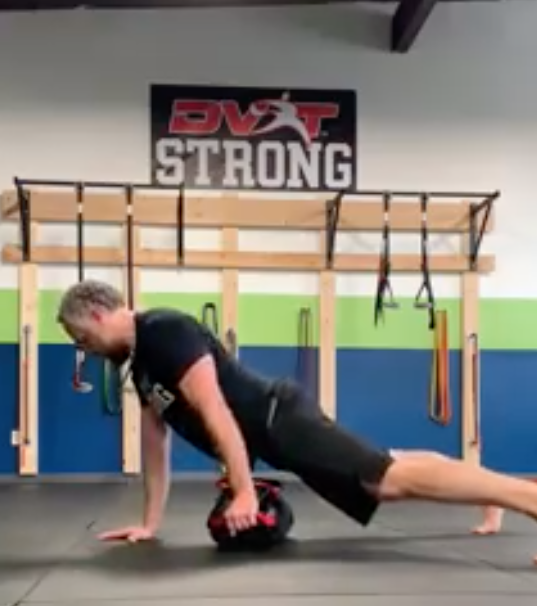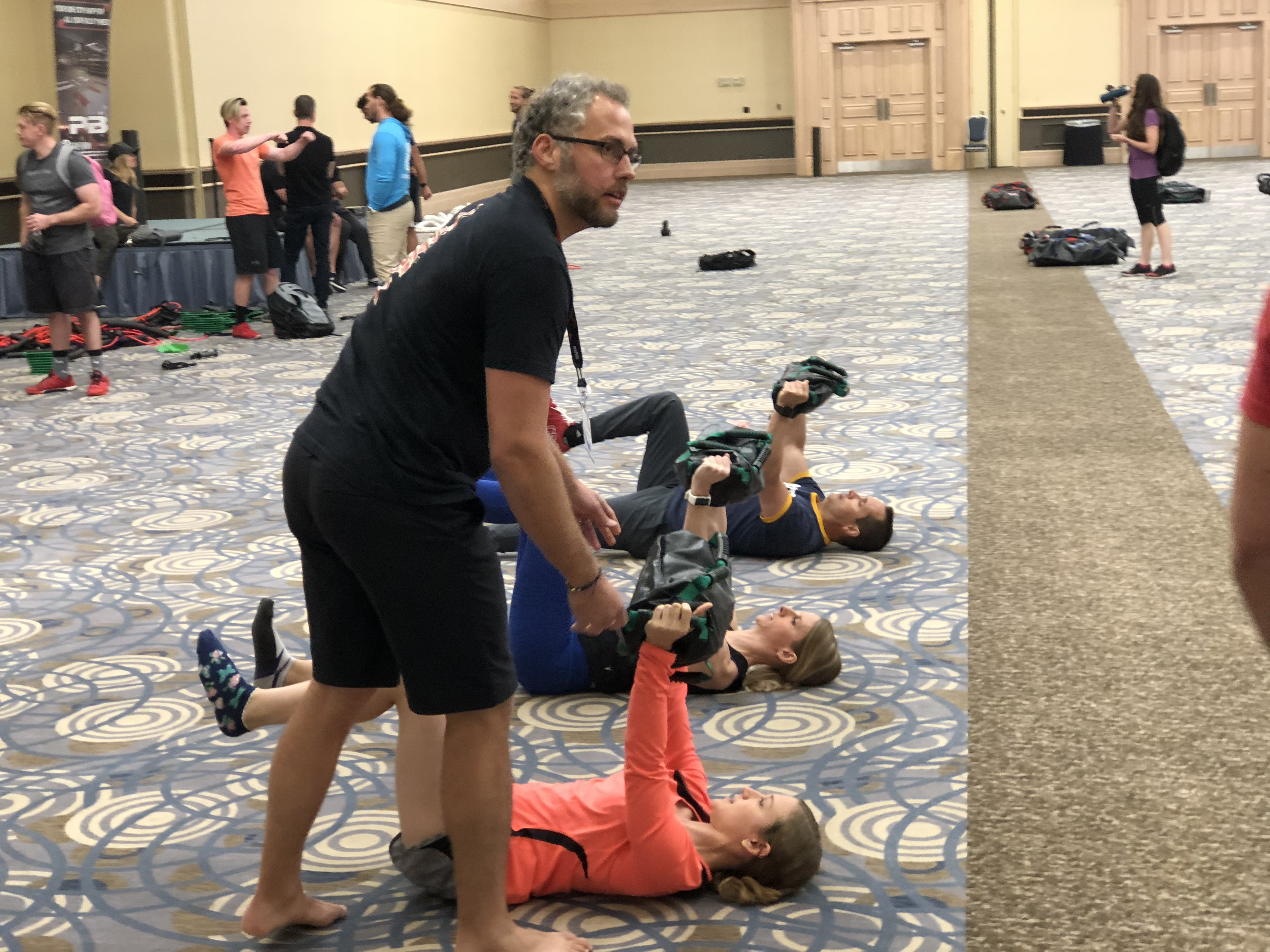How DVRT Makes WAY Better HIIT Workouts
2019-07-15
Cory Cripe, DVRT Master (Creator DVRT Dynamic Strength & Movement Strength Programs)

I am never shy of saying how the success of my gym, Fitness Lying Down, is a direct result of our relationship with DVRT and the implementation of this unique system into our programming. I revel in the ability to use the science DVRT lays out and couple that with my creativity to come up with programs that build a unique strength in our clients that many gyms and training programs fail to deliver.
I mean I am so proud of what DVRT means to Fitness Lying Down that I went out and had a banner made that shows our love for being DVRT STRONG! We are so immersed with DVRT and make it 100% of our programming that you would think this is the norm in the fitness industry. Just recently, however, I was discussing with one of our coaches that even though DVRT feels so natural to us in our little, humble gym – unfortunately, it’s not the same everywhere else.

And why is that? Our DVRT community can see the effects and benefits from using this system – but why doesn’t the rest of the fitness industry see with our lens? With all the knowledge and learning and information provided for us, why do so many functional training exercises still look like isolated body building routines? Why is increasing the weight/load still the most popular way to increase intensity instead of manipulating body position, holding position, & planes of motion? And why is Monday still International Bench Press Day?
You may have noticed that I put out a lot of content on social media of our clients doing some very fundamental DVRT drills and then some very complex drills using the Ultimate Sandbag, kettlebells, lever bells, resistance bands, ARES sled, and more. I do this for many reasons. One, is because I am so proud of our clients and the success they are having at Fitness Lying Down – I like to show them off! Another reason is so our audience can see these exercises aren’t only done by the professionals, but are accessible to all!
https://www.instagram.com/p/ByawKF-htpq/
And I do hope that this inspires fitness professionals, as well as enthusiasts, to see how “ordinary” people can do some pretty extraordinary strength training exercises. Everything we do follows the DVRT system and has purpose. I know for many on the outside looking in a lot of what they see may appear to be circus tricks that will end up hurting someones back. While at the same time, those of us on the inside will say, ‘Holy cow! That is a pretty advanced hip hinge drill – look at those feet!’
I take the responsibility of being a DVRT master instructor as serious as I do being a fitness business owner, coach, & program design master. This is the reason I find purpose in inspiring, motivating, and educating anyone open to having a better DVRT experience in whatever way I can – Fitness Lying Down client or not!
It seems to me that a large obstacle impeding people’s progress of implementing DVRT into their training sessions is programming. How can we successfully create a functional training environment that will strengthen the entire body and not miss a single muscle group?

It isn’t about teaching exercises, it IS about teaching people how to use simple cues to better understand how to use their bodies!
I struggled with this myself in the beginning. Listen, I don’t want to say I was wrong with the programs I created in the past. I worked with what I knew at the time. And as the years have gone on and I’ve increased in knowledge and learning experience I have been able to build better, more efficient programs as a result! This whole fitness professional thing is a process and journey with many ups and downs.
Here’s a little of my dark past – I participated in International Bench Press Day on Mondays, too. But that wasn’t enough; I would also throw in some incline bench press, dumbbell flys, and of course decline bench presses because I had to hit that spot on my pecs that the other exercises couldn’t get to. What I failed to realize was the imbalance I was creating not in body parts, but in movement patterns. Offsetting my pressing and flys with some sets of lat pulldowns and seated rows still didn’t bring me any closer to keeping the movement patterns in check. But let’s be honest, at that stage in my career I really didn’t understand patterns, I just saw exercises.
Honestly, I still have much to learn and to get better at, but for now I feel I have a pretty good grasp on the important ingredients it takes to build a successful program. That’s why I am excited to take this time and uncover for you the “secret sauce” I use at FLD to make our clients better in and out of the gym! And it really isn’t much of a secret because the DVRT universe continues to hand this treasure out on a daily basis.
The secret lies in better understanding the 7 primal movement patterns and their place in your training programs. In case you have been living under a rock, the 7 human primal movement patterns are:
- Squat
- Hinge
- Push (horizontal/vertical)
- Pull (horizontal/vertical)
- Lunge
- Rotation/Anti-Rotation
- Gait
Looking at this list, I always make sure each movement pattern is trained somehow, someway during each one of our clients’ sessions. And the beauty of looking at programming through this recipe is there isn’t any redundancy of exercises, which will save you and your clients’ a lot of time not wasted on exercises that have no business on the movement pattern platform.
As much as it pains me to say it, but if you were to look at the barbell bench press as an important part of your training program, then that is your horizontal press for the day. No more reasons to take part in inclines or declines or “flys.” But now I hope you see how your time is so much more precious and how the exercise selection should be better chosen – you will find the bench press to be a complete waste of programming time! What if you took that barbell bench press and made it into a kettlebell one-arm bench press? Now you have the press component along with an anti-rotational movement. Killing two birds with one stone. SMART.
https://www.instagram.com/p/Bs82EGkBc1i/
Are we training our “chest” in these drills? Absolutely, but there is SO much MORE going on too!
I’ve always been a huge fan of Dr. Stu McGill and his work, and one of my favorites of his is taking that one-arm bench press and moving your body off the bench so half of it was on the bench and the side with the one arm press was off the bench? Now we’ve seriously introduced an anti-rotational component to your horizontal press! However for me and those I train at FLD, we have no benches so we take all our horizontal presses and do them in an upright posture and we can drastically increase the intensity by using our beloved Core Straps from DVRT – you just can’t go wrong!
https://www.instagram.com/p/BymxqGbhHs_/
Taking “chest training” and making it a full body workout!
Looking at the movement pattern list, should squats be defined as something with a bar on your back and your feet shoulder width apart? Heavens no! We can take our squat pattern in so many ways (like Burger King – have it your way)! Ultimate Sandbag in a bear hug holding position with the feet in a sprinters stance will light your core up like a Christmas Tree in December! Holding the USB on your fists as you move in a split squat will make you feel all those feelings. Have you ever squatted with a 115lb USB on your shoulder? Then you haven’t lived, my friend! But that is your squat movement for the day!
Allow me to break this down using the Metabolic Resistance Training (MRT) protocols set up by Coach Dos:
15:45
(15 seconds of work: 45 seconds of rest)
4 to 5 rounds
- KB 1A Racked Reverse Lunge (R) – lunge, anti-rotation, gait
- USB Tall K OH Press – vertical press
- KB 1A Racked Reverse Lunge (L)
- USB Good Morning – hinge
- Suspension Push-Ups – horizontal press
- USB Bearhug Squat – squat
- Chin-Ups – vertical pull
30:30
(30 seconds of work: 30 seconds of rest)
3 to 4 rounds
- USB Bear Hug Squat & Alt Rotation – squat, rotation
- KB Swings – hinge
- USB Alt 1/2 K Arc Press – vertical press, vertical pull
- USB FL Alt Lateral Lunge – lunge, anti-rotation
- USB Bird Dog ISO Drag – press, gait
- 2KB Seesaw BOR – horizontal pull
20:40
(20 seconds of work: 40 seconds of rest)
4 to 5 rounds
- USB Inside-Out Power Cleans – hinge
- USB Shoulder SP Squat (R) – squat, anti-rotation
- USB Shucking Rows – horizontal pull, hinge
- USB Shoulder SP Squat (L)
- Suspension Muscle Ups – vertical pull, horizontal press
- KB 1A OH Carry (R) – gait, vertical press
- KB 1A OH Carry (L)
I’m sure it’s easy to pick out most of the movement patterns like squats, lunges, hip hinges, etc. However, there might be some patterns that are “hidden” and not so easily seen. As you learn more about how the body moves and train it according to these principles then you will find a more balanced training session with less wear & tear and bodies that are more adaptable for real life resiliency.
You don’t need a whole bunch of equipment and exercises to receive an effective training session. All you need is some sound science, a little creativity, and ongoing experience to deliver a stimulating DVRT experience!
Don’t miss getting 30% off Cory’s great programs with coupon code “summersale” HERE
© 2025 Ultimate Sandbag Training. Site by Jennifer Web Design.







